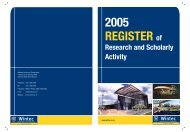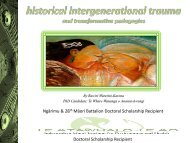Determination of EDTA in Dairy Wastewater and Adjacent Surface ...
Determination of EDTA in Dairy Wastewater and Adjacent Surface ...
Determination of EDTA in Dairy Wastewater and Adjacent Surface ...
You also want an ePaper? Increase the reach of your titles
YUMPU automatically turns print PDFs into web optimized ePapers that Google loves.
PROCEEDINGS OF WORLD ACADEMY OF SCIENCE, ENGINEERING AND TECHNOLOGY VOLUME 34 OCTOBER 2008 ISSN 2070-3740<br />
Retention time (m<strong>in</strong>)<br />
Fig. 8 Typical chromatogram <strong>of</strong> a surface water sample with 1.7 µg L -1<br />
<strong>of</strong> <strong>EDTA</strong><br />
<strong>EDTA</strong> Con. (µg L -1 )<br />
Peak height (mv)<br />
Fe(III)<strong>EDTA</strong><br />
Fe(III)<strong>EDTA</strong><br />
[3] European Union, “Tetrasodium Ethylenediam<strong>in</strong>eacetate(Na 4 <strong>EDTA</strong>),<br />
European Union Risk Assessment Report, ” E. C. Bureau, 2004<br />
[4] Biogeochemistry <strong>of</strong> Chelat<strong>in</strong>g Agents, Vol. ACS910, B. Nowack <strong>and</strong> J. M.<br />
VanBriesen, Eds. Oxford University Press, Wash<strong>in</strong>gton D.C., 2005, p.458<br />
[5] M. Bucheli-Witschel <strong>and</strong> T. Egli, “Environmental fate <strong>and</strong> microbial<br />
degradation <strong>of</strong> am<strong>in</strong>opolycarboxlic acids,” FEM Microbiology Review<br />
Vol. 25, pp. 69-106, 2001<br />
[6] C. E. Cagnasso, L. B. Lόpez, V. G. Rodríguez <strong>and</strong> M. E. Valencia,<br />
“Development <strong>and</strong> validation <strong>of</strong> a method for the determ<strong>in</strong>ation <strong>of</strong> <strong>EDTA</strong><br />
<strong>in</strong> non-alcoholic dr<strong>in</strong>ks by HPLC,” Journal <strong>of</strong> Food Composition <strong>and</strong><br />
Analysis, Vol. 20, pp. 248-25, 2007<br />
[7] S. Loyaux-Lawniczak, J. Douch <strong>and</strong> P. Behra, “Optimisation <strong>of</strong> the<br />
analytical detection <strong>of</strong> <strong>EDTA</strong> by HPLC <strong>in</strong> natural waters”, Fresenius J<br />
Anal Chem, Vol. 364, pp.727-731,1999<br />
[8] B. Nowack, F. G. Kauri, S. U. Hilger, <strong>and</strong> L. Sigg, “<strong>Determ<strong>in</strong>ation</strong> <strong>of</strong><br />
dissolved <strong>and</strong> adsorbed <strong>EDTA</strong> species <strong>in</strong> water <strong>and</strong> sediments by HPLC,”<br />
Anal Chem, Vol. 68, pp. 561-566,1996<br />
[9] P. M. Nirel, P. E. Pardo, C. L<strong>and</strong>ry <strong>and</strong> R. Revalier, “ Method for <strong>EDTA</strong><br />
speciation determ<strong>in</strong>ation : application to sewage treatment plant<br />
effluents,” Water Res, Vol.32, pp. 3615-3620, 1998<br />
[10] P. La<strong>in</strong>e <strong>and</strong> R. Matil<strong>in</strong>en, “Simultaneous determ<strong>in</strong>ation <strong>of</strong> DTPA, <strong>EDTA</strong>,<br />
<strong>and</strong> NTA by UV-visible spectrometry <strong>and</strong> HPLC,” Anal Bioanal Chem,<br />
Vol. 382, pp.1601-1609, 2005<br />
[11] Germany st<strong>and</strong>ard methods DIN 38413 – 8, 2000<br />
[12] L. Katata, V. Nagaraju <strong>and</strong> A. M. Crouch, “<strong>Determ<strong>in</strong>ation</strong> <strong>of</strong><br />
ethylenediam<strong>in</strong>etetraacetic acid, ethylenediam<strong>in</strong>edisucc<strong>in</strong>ic acid <strong>and</strong><br />
im<strong>in</strong>odisucc<strong>in</strong>ic acid <strong>in</strong> cosmetic products by capillary electrophoresis <strong>and</strong><br />
high performance liquid chromatography,” Analytica Chimica Acta, Vol.<br />
579, pp. 177-184, 2006<br />
[13] L. R. Snyder, J. J. Kirkl<strong>and</strong> <strong>and</strong> J. L. Glajch, Practical HPLC method<br />
Development,2 nd Ed, A Wiley-Interscience publication, JOHN WILLEY<br />
& SONS, INC, 1997<br />
Sampl<strong>in</strong>g sites<br />
Fig. 9 <strong>EDTA</strong> concentrations upstream <strong>and</strong> downstream <strong>of</strong> dairy<br />
effluent discharge <strong>in</strong> the adjacent surface water<br />
IV. CONCLUSION<br />
An HPLC-UV analytical method was described to determ<strong>in</strong>e<br />
<strong>EDTA</strong> as Fe(III)<strong>EDTA</strong> us<strong>in</strong>g UV detection. The<br />
chromatography separation was optimized by adjust<strong>in</strong>g<br />
compositions <strong>of</strong> the mobile phase <strong>and</strong> flow rate on a C18<br />
reversed-phase column. The possible <strong>in</strong>terferences <strong>of</strong> nitrate,<br />
calcium <strong>and</strong> magnesium from dairy waste waters were<br />
<strong>in</strong>vestigated <strong>and</strong> no <strong>in</strong>terference found. <strong>Dairy</strong> waste waters with<br />
vary<strong>in</strong>g <strong>EDTA</strong> levels between µg L -1 to mg L -1 were analyzed<br />
with an acceptable repeatability (duplicate) <strong>and</strong> reproducibility<br />
(spike recovery). The method detection limit was 5 µg L -1 .<br />
The method was applied to determ<strong>in</strong>e <strong>EDTA</strong> <strong>in</strong> the adjacent<br />
surface water <strong>in</strong>to which large amounts dairy effluents (7,000<br />
m 3 ) were discharged. A contribution <strong>of</strong> <strong>EDTA</strong> from the dairy<br />
effluent was observed at 60 m downstream before the other<br />
stream jo<strong>in</strong>ed <strong>in</strong>, but not 10 m downstream <strong>of</strong> the discharge.<br />
Overall <strong>EDTA</strong> concentrations <strong>in</strong> the adjacent surface water<br />
were less than 3 µg L -1 . This was well under the predicted no<br />
effect concentration for aquatic ecosystem.<br />
REFERENCES<br />
[1] G. Bylund, “Clean<strong>in</strong>g <strong>of</strong> dairy equipment,” <strong>in</strong> <strong>Dairy</strong> Process H<strong>and</strong>book;<br />
Lund, Sweden: Tetra Pak Process<strong>in</strong>g Systems AB, 1995, pp. 403-413<br />
[2] K. Wolf <strong>and</strong> P. A. Gilbert, “<strong>EDTA</strong>-Ethylenediam<strong>in</strong>etetraacetic Acid,” <strong>in</strong><br />
The H<strong>and</strong>book <strong>of</strong> Environmental Chemistry, Vol. 3, O. Hutz<strong>in</strong>ger, Ed.<br />
Spr<strong>in</strong>ger-Verlag Berl<strong>in</strong> Heidelberg, 1992, pp. 243- 259<br />
PWASET VOLUME 34 OCTOBER 2008 ISSN 2070-3740 54 © 2008 WASET.ORG

















